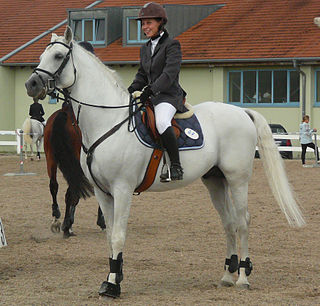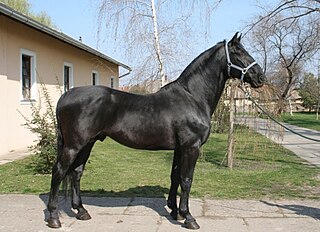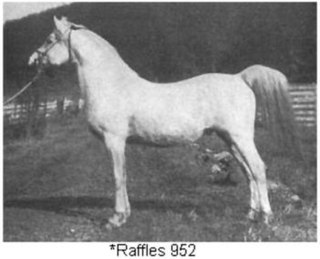
Horse breeding is reproduction in horses, and particularly the human-directed process of selective breeding of animals, particularly purebred horses of a given breed. Planned matings can be used to produce specifically desired characteristics in domesticated horses. Furthermore, modern breeding management and technologies can increase the rate of conception, a healthy pregnancy, and successful foaling.

The Lipizzan or Lipizzaner is a European breed of riding horse developed in the Habsburg Empire in the sixteenth century. It is of Baroque type, and is powerful, slow to mature and long-lived; the coat is usually gray.

The Spanish Riding School is an Austrian institution dedicated to the preservation of classical dressage and the training of Lipizzaner horses, based in Vienna, Austria, whose performances in the Hofburg are also a tourist attraction. The leading horses and riders of the school also periodically tour and perform worldwide. It is one of the "Big Four", the most prestigious classical riding academies in the world, alongside the Cadre Noir, the Portuguese School of Equestrian Art, and the Royal Andalusian School.

The Ukrainian Riding Horse or Ukrainian Saddle Horse is a modern Ukrainian breed of warmblood sport horse. Breeding began in the years after the Second World War at the stud farm of Dnipropetrovsk in central Ukraine – at that time in the USSR – and later expanded to three other state stud farms. It derives from cross-breeding of Hanoverian, Thoroughbred and Trakehner stallions with local mares or with Hungarian Furioso, Gidran Arab or Nonius mares. It incorporates the last bloodlines of the extinct Orlov-Rostopchin or Russian Saddle Horse. It was bred to compete in show jumping, three-day eventing and dressage, but is also suitable as a general riding horse.

Alois Podhajsky was the director of the Spanish Riding School in Vienna, Austria as well as an Olympic medal-winner in dressage, riding instructor, and writer. He competed at the 1936 Summer Olympics and the 1948 Summer Olympics.

The Crabbet Arabian Stud, also known as the Crabbet Park Stud, was an English horse breeding farm that ran from 1878 to 1972. Its founder owners, husband and wife team Wilfrid Scawen Blunt and Lady Anne Blunt, decided while travelling in the Middle East to import some of the best Arabian horses to England and breed them there. They maintained the Sheykh Obeyd estate near Cairo to facilitate this. Their daughter Judith Blunt-Lytton, 16th Baroness Wentworth carried on the stud until her death. The stud was sold up in 1971, but its bloodlines continue to influence the breed worldwide in the 21st century.

A stud farm or stud in animal husbandry is an establishment for selective breeding of livestock. The word "stud" comes from the Old English stod meaning "herd of horses, place where horses are kept for breeding". Historically, documentation of the breedings that occur on a stud farm leads to the development of a stud book. Male animals made available for breeding to outside female animals are said to be "standing at stud", or at "stud service", referencing the relatively high probability that they are kept at a stud farm.

The Kladruber is the oldest Czech horse breed and one of the world's oldest horse breeds. It is considered very rare. The chief breeder and the keeper of the studbook is the National Stud at Kladruby nad Labem in the Czech Republic where Kladrubers have been bred for more than 400 years. Kladrubers have always been bred to be a galakarossier – a heavy type of carriage horse for the court of the House of Habsburg.

The Shagya Arabian is a horse breed which was developed in the Austro-Hungarian Empire during the 19th century at the Bábolna, Mezőhegyes, Radautz, Piber, and Topolcianky studs. Today it is most often seen in the Czech Republic, Austria, Romania, the former Yugoslavian countries, Poland, Germany, and Hungary, but has been exported to other nations and is bred around the world. A purebred Shagya Arabian today has bloodlines that can be traced in all lines to the stud books of Rădăuți, Babolna, and Topolcianky. The breed is considered by some to be a subtype of Arabian horse, but due to the presence of a small amount of non-Arabian breeding others consider it to be an Anglo-Arabian or a partbred Arabian.

The Nonius is a Hungarian horse breed named after its Anglo-Norman foundation sire. Generally dark in color, it is a muscular and heavy-boned breed, similar in type to other light draft and driving horses. The breed was developed at the Imperial Stud at Mezőhegyes, Hungary by careful linebreeding. Originally bred to serve as a light draft and utility horse for Hungary's military, the breed became a useful agricultural horse during the 20th century. The depredations of World War II significantly reduced the Nonius' population, and in the decades after the war, a downturn in the usage of horses in Hungary sent many members of the breed to slaughter. Today the breed is bred by preservationists and is used in agriculture, leisure riding, and competitive driving sports. The largest numbers of Nonius horses are still found at Mezőhegyes, with representatives in other eastern European nations as well.

Miracle of the White Stallions is a 1963 American adventure war film released by Walt Disney starring Robert Taylor, Lilli Palmer, and Eddie Albert. It is based on the story of Operation Cowboy which was the evacuation of the Lipizzaner horses from the Spanish Riding School in Vienna during World War II. Major parts of the movie were shot at the Hermesvilla palace in the Lainzer Tiergarten of Vienna, a former hunting area for the Habsburg nobility. The music for the soundtrack was based on the first movement of Franz Schubert's Marche Militaire no 1, D733.

Raffles was an Arabian stallion foaled in 1926 and imported to the United States by Roger Selby in 1932. Raffles was bred by Lady Wentworth of the Crabbet Arabian Stud.

Witez II was a bay Arabian stallion foaled at the Janów Podlaski stud in Poland. He spent his early years at Janów at a time when Poland was under occupation by Nazi Germany before ultimately arriving in the United States in 1945, where he lived for the remainder of his life until his death. His name came from an archaic Polish word meaning "chieftain, knight, prince and hero."
An Austrian Warmblood is a warmblood type of horse registered with the Arbeitsgemeinschaft für Warmblutzucht in Österreich. Although the studbook is made up of jumping and dressage horses from many other countries, the mare base consists of native horses with a long history. The AWÖ keeps an open studbook, in which mares and stallions must pass rigorous inspections before becoming breeding stock.

The Neapolitan Horse, Italian: (Cavallo) Napoletano, Neapolitano or Napolitano, is a horse breed that originated in the plains between Naples and Caserta, in the Campania region of Italy, but which may have been bred throughout the Kingdom of Naples. The Neapolitan horse was frequently mentioned in literature from the 16th to the 19th centuries, and is noted for its quality. Corte wrote in 1562: "in Italy the horses of the Kingdom of Naples are greatly esteemed; [there] many fine coursers are born ... suitable for use in war and in the manège and for every service that the rider may require". The decline of the breed was noted in the early 20th century by Mascheroni (1903) and Fogliata (1908). Some sources state that by 1950, the original Neapolitan horse was deemed extinct, but its lines were incorporated into other breeds, most notably the Lipizzaner. An attempt to recreate this breed resulted in the modern breed called Napolitano.

The Piber Federal Stud is a stud farm dedicated to the breeding of Lipizzan horses, located at the village of Piber, near the town of Köflach in western Styria, Austria. It was founded in 1798, began breeding Lipizzan horses in 1920, and today is the primary breeding farm that produces the stallions used by the Spanish Riding School, where the best stallions of each generation bred at Piber are brought for training and later public performance. One of Piber’s major objectives is "to uphold a substantial part of Austria’s cultural heritage and to preserve one of the best and most beautiful horse breeds in its original form."

The Lipik Stud is a Croatian Lipizzan horse national breeding stud farm located in Lipik, Požega-Slavonia County. The Stud originated in 1843 as count Izidor Janković built large stables on his estate. Today it comprises approximately 106 acres in the western part of the Town of Lipik, with a total of 74 horses, 70 of which are Lipizzans.

The Đakovo Stud is a Croatian Lipizzan horse national breeding stud farm located in Đakovo, Osijek-Baranja County, eastern Slavonia. First mentioned in 1239 and 1244, it officially originated in 1506, as it was written that Bishop Mijo Mesarić „owned a stud farm of 90 Arab horses“ on his estate. In recent times, it has developed into an important breeding farm, which comprises today approximately 790 acres of land and breeds as many as 160 horses in the Town of Đakovo and its surroundings.
Saklawi, Seglawi or Siglavy in Central Europe, is one of the five mythical Arabian horse bloodlineages recognized as pure by the Bedouins, the Al Khamsa. Selected by the Ruwallah and Anizah, two nomadic tribes of the Arabian Desert, this lineage was imported to Egypt several times in the 19th and 20th centuries, and is still bred today in Saudi Arabia and Iran.
Siglavy was a gray Arabian horse at the origin of one of the Lipizzan bloodlineages, which bears his name, thanks to his activity as a stallion at the Lipica stud farm. He is also one of the five heads of Shagya bloodlineages.

















